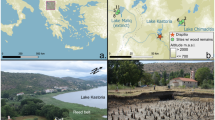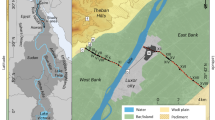Abstract
THE deep sediments of Rostherne Mere, Cheshire (National Grid Reference SJ 745843) offer a promising situation in which to study the relationship between biological stratification and radionuclide dating in the absence of gross bioturbation. The mere is small (46.5 hectare), but relatively deep (30 m maximum), and is reported to be largely devoid of benthic fauna in the persistently deoxygenated deep sediments1. The sediments of Rostherne Mere contain the remains of a great variety of algae, in addition to diatoms. The preservation of non-siliceous algae is uncommon, although found in the sapropel deposits of the USSR2. In Rostherne the empty spores of Ceratium hirundinella O.F. Mull., Anabaena species and Aphanizomenon flos-aquae (L) Ralfs are recognisable, as are colonies of Microcystis species and cells of Staurastrum species. The phytoplankton of Rostherne Mere has been recorded at intervals since 1912 (refs 3–5) and sampled more frequently from 1962 (refs 6–8). The recent records (Table 1) show fluctuations in summer dominance, mainly between Ceratium hirundinella and Microcystis aeruginosa Kütz. emend., but blue–green algae have become increasingly dominant9. These changes, combined with occasional maxima of the diatoms Melosira granulata (Ehr.) Ralfs, Cyclotella pseudostelligera Hust. and Stephanodiscus astraea (Ehr.) Grun., can be correlated with algal assemblages in the sediments and permit these to be accurately dated. We now report that such algal remains from the lake sediment have been used to establish a detailed chronology which is shown to confirm the 137Cs dating method.
This is a preview of subscription content, access via your institution
Access options
Subscribe to this journal
Receive 51 print issues and online access
$199.00 per year
only $3.90 per issue
Buy this article
- Purchase on Springer Link
- Instant access to full article PDF
Prices may be subject to local taxes which are calculated during checkout
Similar content being viewed by others
References
Brinkhurst, R. O. & Walsh, B. J. Fish. Res. Bd Can. 24, 1299–1309 (1967).
Korde, N. V. Moskva: Izd. Akad. Nauk SSR (1960).
Pearsall, W. H. Mem. Proc. Manchr lit. Phil. Soc. 67, 45–55 (1923).
Griffiths, B. M. J. Linn. Soc. Bot. 47, 75–98 (1925).
Lind, E. M. Mem. Proc. Manchr lit. Phil. Soc. 86, 83–105 (1944).
David, J. E. Rep. Nature Conservancy Council, Shrewsbury (1964).
Belcher, J. H. & Storey, J. E. Naturalist, Hull 905, 57–61 (1968).
Reynolds, C. S. Br. Phycol. J. (in the press).
Reynolds, C. S. & Rogers, D. A. Hydrobiologia 48, 17–23 (1976).
Mackereth, F. J. H. Limnol. Oceanogr. 14, 145–151 (1969).
Pennington, W., Cambray, R. S. & Fisher, E. M. Nature 242, 824–826 (1973).
Ritchie, J. C., McHenry, J. R. & Gill, A. C. Limnol. Oceanogr. 18, 254–263 (1973).
Salmon, L. & Creevy, M. G. Salzburg Symp. 47, (IAEA, Vienna) (1971).
Gaskell, S. J. & Eglinton, G. Geochim. cosmochim. Acta 40, 1221–1228 (1976).
Pennington, W., Cambray, R. S., Eakins, J. D. & Harkness, D. D. Freshwater Biol. 6, 317–331 (1976).
Author information
Authors and Affiliations
Rights and permissions
About this article
Cite this article
LIVINGSTONE, D., CAMBRAY, R. Confirmation of 137Cs dating by algal stratigraphy in Rostherne Mere. Nature 276, 259–261 (1978). https://doi.org/10.1038/276259a0
Received:
Accepted:
Issue Date:
DOI: https://doi.org/10.1038/276259a0
This article is cited by
-
Source and quantity of carbon influence its sequestration in Rostherne Mere (UK) sediment: a novel application of stepped combustion radiocarbon analysis
Journal of Paleolimnology (2020)
-
A comprehensive study on water balance, sedimentation and physico-chemical characteristics of Sagar Lake in India
Environmental Monitoring and Assessment (2009)
-
Estimation of Sediment Rates and Life of Sagar Lake Using Radiometric Dating Techniques
Water Resources Management (2008)
-
The representation of diatom communities by fossil assemblages in a small acid lake
Journal of Paleolimnology (1995)
-
Interpretation of caesium-137 profiles in lacustrine and other sediments: the role of catchment-derived inputs
Hydrobiologia (1992)
Comments
By submitting a comment you agree to abide by our Terms and Community Guidelines. If you find something abusive or that does not comply with our terms or guidelines please flag it as inappropriate.



